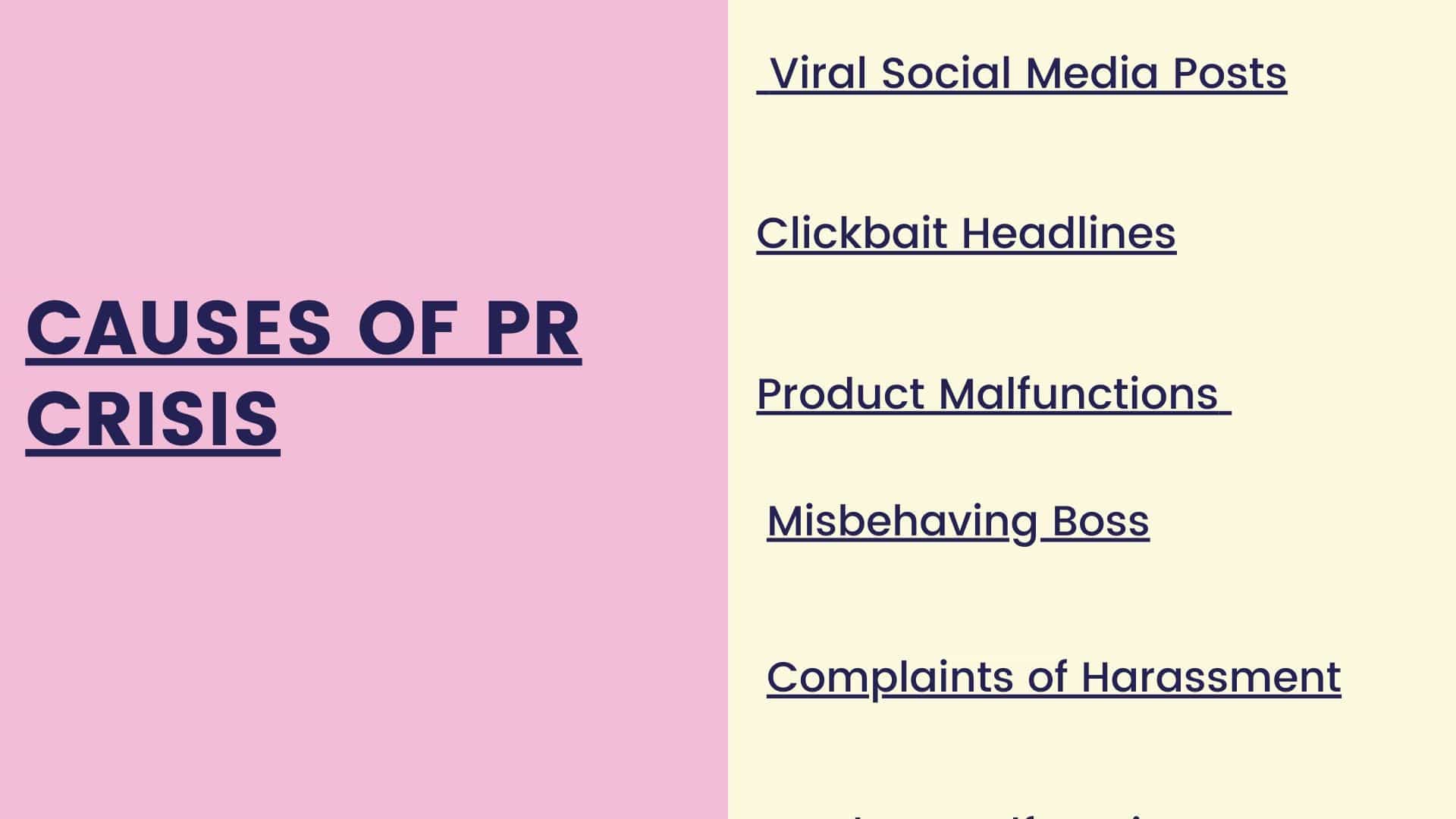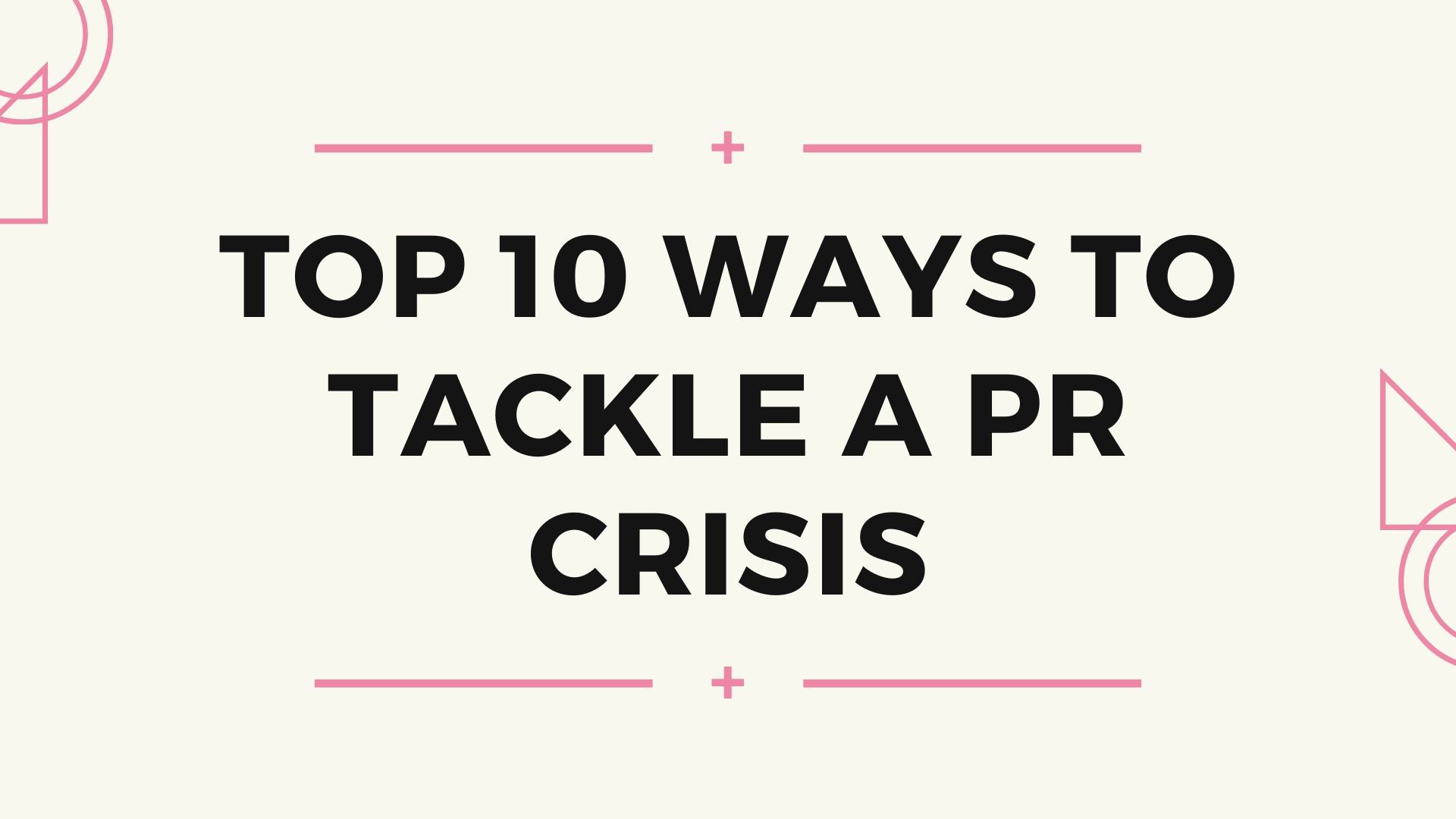PR crisis is a public relations nightmare that can cause serious damage to a company’s reputation. It includes any scandal or controversy, ranging from social media blunders to government investigations. To manage this type of situation, companies need to be prepared and have a crisis management team in place.
The PR Crisis team should know how to triage the problem as it arrives on their desk and approach it with the right Brand Voice. A successful Public Relations Crisis team can contain the issue while defending the brand’s reputation and keeping the public informed through a professional yet empathetic approach.
It is a form of bad publicity that may negatively affect the optimum operational capacity of your company. Such a PR crisis may go beyond the control of the marketing or PR team, and to resolve such issues, company leaders and management may be required to get involved. So, in the purest form, the Public Relations crisis can be understood as a black mark on your brand, industry, or niche, and that is why it is essential to understand what it is, different scenarios when it may occur, and how you can resolve such crises.
Table of Contents
What is PR Crisis?
A PR crisis refers to a critical situation that jeopardizes the reputation of an organization. It can arise due to various factors and poses a substantial threat to the organization’s image. A few examples of a PR crisis can be poor customer service, allegations of misconduct, a scandal involving the company’s leadership team, and negligence in product quality.
The main goal of Public Relations crisis management is to react quickly and professionally to protect the reputation of your company. It requires comprehensive planning, clear communication strategies, and effective problem-solving techniques. Additionally, stakeholders must be kept informed about the situation as it unfolds so that they can make the best decisions for the organization.
A PR crisis occurs when a beating is taken by the status of the company. In business, it takes years to build a good reputation, and no one can afford to lose it instantly. That makes the Public Relations crisis one of the most dreaded issues faced by a company. There are various causes for the same, like bad publicity or extensive spread of harmful rumors, product or service failure, etc.
In today’s world, where the internet rules; any negative comment/sentiment/reply can harm the goodwill of any company. The most disastrous effect of this Public Relations crisis is a breach of trust. Trust is undoubtedly the most coveted quality, not just in personal life but also in professional life. It takes a toll on the trust instilled by the clients and customers in a company and makes them doubt their decision. Therefore, managing it and recovering from it at the earliest is of the utmost importance.
What is PR or Public Relations?
Public Relations (PR) is the practice of managing and controlling how an organization is perceived by the public. It is a type of communication used to maintain or build relationships with stakeholders, potential customers, employees, and other parties that are interested in your business. The main goal of PR is to create positive publicity for an organization and its products or services.
Any business is set up with the hope of making it reach the most excellent height and incurring huge profits through the products or services provided to the clients. A business is made up of various aspects like the nature of the product or service, its client base, the turnover expected, and many more. Hence, one needs a business plan in place to achieve all these things.
An essential factor is the quality, efficiency, and design of the product or service being provided. We must remember that only the best quality sustains the tides of time and trials in the market. The product should necessarily be designed and developed by considering the requirements of the client and trying to fulfill them to the best of their capacity.
The second most important factor is marketing or publicity. We need to promote a product based on its plus points and usage. This is where the PR comes into the picture. As mentioned earlier, the public which constitutes of clients, customers, and the overall population is an essential part of a business. The company can promote the product among these groups and facilitate better business. The PR circulates information about an individual, company, product, or service among the masses by using the correct ways and means.
What can be the Causes of a Public Relations Crisis?
There are several reasons for a PR crisis situation. In every business, there are lots of people involved. There are stakeholders of many sorts who need to be given the result and respect they rightly deserve. Any breach in both of these can lead to a Public Relations (PR) disaster. Here are some details on its causes:
1. Viral Social Media Posts
Social media takes the cake in creating a PR crisis. The horrendous social media trials and trolling have fuelled the Public Relations crisis.
One negative comment or improper reply leads to a disaster. It influences millions of people in one go. At a time, when social media is so prevalent across the globe, it can be a significant factor in a PR crisis.
Handling the negative sentiments of users and potential buyers is very important, and if you fail in doing so, it can aggravate your crisis.
2. Clickbait Headlines
A Clickbait headline compels the reader to dive into it and read the article.
To make the article or the headline spicy and catchy, one can circulate incorrect and improper information. That may lead to a PR crisis.
You must offer your customers the same product or service that you promise, and when you fail in doing so, it may cause a PR crisis for you.
3. Product Malfunctions and Recalls
Not every story about a company or a product is untrue.
Sometimes, the quality of the product is genuinely poor, leading to malfunctions and recalls.
Repetitive failure cases and their complaints can also cause a PR crisis.
So, when you not only fail in maintaining the quality of your products but also fail in responding to the complaints of your users, it will cause a PR crisis for your brand.
4. Misbehaving Boss or Rebellious Employees
In any company, the boss and employees need to share an amicable relationship.
If the boss repeatedly misbehaves or the employees rebel unnecessarily, it can harm the company’s position in the market.
Lack of adequate employee management can always be the reason for the PR crisis.
5. Complaints of Harassment
It is illegal and unethical to harass any employee physically, emotionally, or sexually. It is excellent that these aspects are gaining importance nowadays.
But, such complaints against anyone in the company can ruin the reputation and PR of the company straight away.
A company that fails in incorporating and implementing guidelines for such unacceptable behaviors will always be vulnerable to such sorts of Public Relations crises.
Now, as you have gone through some of the causes of a PR crisis, let us have a look at two of the most famous PR Crises here, so you can understand how things change negatively for a brand and become into a crisis-
Examples of Public Relations Crises
Some of the most popular Public relations crises are –
1) YouTube Scandal of Domino’s
In the year 2009, two of the employees of Domino’s posted a YouTube video of preparing food in a distasteful manner.
The company did not react to it immediately, and as per the reports of the New York Times, within a few hours, it did negative branding for Domino’s. Even Domino’s management offered an apology, but it did not work.
2) Greenpeace vs Nestle
In the year 2010, Greenpeace made a YouTube video against Nestlé’s use of Palm oil.
Their video was a parody of a Kit Kat ad in which when an office worker opens a Kit Kat chocolate; he finds an orangutan finger. This video parody was made to showcase how Nestlé’s sourcing of palm oil is threatening orangutans in Indonesia.
In response to this parody, Nestle contacted YouTube and asked them to remove this video. YouTube removed the video, but by then, it had caused public outrage. People said lots of bad things about Nestle on Social Media.
Nestle even tried to remove those bad comments from social media which was not a good strategy at all; instead, they should try to put forward their side of the story in a polite manner- which they did not, and hence, caused a PR crisis.
PR Disasters of 2022
3) Will Smith vs Chris Rock aka The Slap
During the 2022 Academy Awards, in a shocking moment on live television, Will Smith momentarily lost control and delivered an unforgettable slap to Chris Rock.
Adding insult to injury, he won the prestigious “Best Actor” award and was allowed to deliver an acceptance speech.
In the weeks following the incident, it became the topic of conversation for everyone. However, throughout it all, Will and his team chose to remain quiet. Only after several months, experiencing a decline in followers and facing a box office failure with his latest film, did Will finally address the incident.
The key takeaway is that it is crucial to take prompt action in managing the narrative during a crisis. Failing to do so will give room for speculation, and your silence will only validate whatever assumptions others may have.
4) Kany West Antisemitic Ranting
Kanye West went on a bizarre antisemitic rant during a concert, which caused widespread outrage. He also had a meltdown during the same show and said some pretty inappropriate things about the audience.
His team initially attempted to downplay the incident by claiming it was taken out of context and merely an artistic expression. However, when no one bought it, they had to revert to a more serious tone and issue an official apology to those that were offended by his anti-semitic remarks.
However, as a result of these inclinations, he has been abandoned by virtually everyone, including his label. He has truly suffered significant financial losses and his reputation is in ruins.
The key takeaway here is that it’s important to have a consistent and responsible brand voice. Even in the face of adversity, one should always maintain their integrity and not succumb to rash decisions or actions which could potentially endanger their public image. As Kanye West has learned, it’s better to take a step back and assess the situation before any damage is done.
5) The Balenciaga Ad Controversy
Balenciaga’s recent campaign seems to have missed the memo that child pornography is never acceptable or trendy. One of their campaigns portrayed children holding teddy bear bags, with the bears wearing S&M-style harnesses, while another displayed copies of a child pornography decision made by the Supreme Court in 2008.
The decision-maker behind this action remains a mystery. However, the reaction was swift, fierce, and undeniably warranted. Influencers quickly distanced themselves, celebrities severed ties, and the situation deteriorated rapidly. Although they issued a statement, it had minimal impact on remedying their predicament.
This incident is a clear example of how important it is to consider the moral implications of your campaigns before you put them into action. It serves as a reminder that companies should always evaluate their promotional materials through the lens of social media and public opinion, rather than relying solely on internal approval. Furthermore, businesses must remain vigilant in monitoring feedback from consumers and the public.
Top PR Crises in 2023 So Far
6) Silicon Valley Bank Collapse
Silicon Valley Bank’s sudden collapse during the Spring sent shockwaves through the global financial industry, causing substantial repercussions for tech start-ups, venture capital, and biotechnology sectors.
According to many observers of the media, the way the company handled its communication strategy during the collapse only made the situation worse. They released a confusing press statement and appeared to be slow in addressing the concerns of investors after a popular newsletter highlighted their high level of debt.
This incident serves as a reminder that companies should be prepared for potential disasters and have effective communication strategies in place to handle them. Businesses should also consider the potential risks of negative coverage before engaging in any risky behavior.
7) Data Breaches
During March, both members of Congress and residents of Washington D.C. faced a cyberattack on an online health insurance marketplace.
Their personal information was jeopardized due to this security breach. Harvard Pilgrim Health Care, located near Boston, experienced a ransomware attack in April. This cyberattack had a significant impact, affecting over 2.5 million individuals.
In the complex realm of online attacks, the initial step is to gather accurate information and comprehend the potential impact of a data breach or security incident on the members of your business or organization.
After understanding the severity of a breach, it’s important to formulate a PR strategy with proper messaging and communication plans. Companies should also consider their legal obligations when responding to any data breaches.
What is PR Crisis Management?
PR Crisis Management is a process of handling issues or situations that could damage the brand’s reputation. It involves developing a crisis communication plan and strategies to reduce the risk of future PR crises, as well as responding properly to an incident when it occurs. A crisis communications plan that gives the appropriate response to a crisis should be integrated into your business strategy.
When handled correctly, PR crises can be used by brands to turn negative opinions into positive ones and build stronger relationships with their customers. Some of the effective PR crisis management tools that can be used by brands include:
- Developing a crisis response plan
- Forming a PR Crisis Response Team
- Adopting an effective communication strategy
- Setting up monitoring systems and tools
- Using proactive media relations
- Having a social media team to manage presence on different social media channels
- Employing consistent branding and messaging, also known as Brand Voice.
By using these PR crisis management tools, a company can quickly respond to a crisis and reduce the damage caused by it. This will help the brand recover from the crisis faster, as well as rebuild trust and loyalty with their customers.
Top 10 Ways to Manage a PR Crisis
1. Know the situation Right
Before managing the situation, you need to know the nitty-gritty of what caused the problem. You cannot plan the correct response method without understanding the situation.
2. Please take responsibility for the crisis
Jerking the responsibility away is no way to get out of it, as doing that will further worsen the situation. It would help if you started communicating with clients as soon as you can.
3. Be Transparent and Responsive
You should never go in the ‘no comments’ zone. The consumers have undoubtedly had a bad experience due to the crisis. Know for yourself that you owe them some response.
4. Identify the Affected Clients
To manage the crisis, you need to know the clients who were affected. That will give you a clearer picture of the repercussions and help you reach out to them better.
5. Devise a Strategy
While running a business, you need to have strategies planned for every known situation. Hence, it will help if you always keep a PR Crisis Management Team ready that will take care of the situation.
6. Circulate a Message
As mentioned earlier, never leave the clients unaddressed. You should circulate a message pacifying them. If you want to know the effects of the crisis on them or clarify your side, do it politely. It is advised to apologize first.
7. Brace Yourself to Face Social Media
In the age of social media, there are severe speculations that spread like wildfire. That leads to social media trials which may be destructive to the company’s reputation. You need to make sure that you are circulating the right information.
8. Monitor an Ongoing Crisis
During times of crisis, you need to have your monitoring team on high alert. You should review the news being circulated and respond to it. Be human and polite while communicating with the clients. Monitoring helps plan a better strategy.
9. Do Not Fuel the Crisis
Anything wrong said or done by the team, or the employees can have a terrible impact. It may make people aggressive, and such incidents ruin the reputation of a company. Hence, the company should behave responsibly.
10. Learn and Grow
You should be aware of what the previous PR crisis was. You can take hints of strategies from that. You also need to take lessons from the current crisis and make use of them in the future. It would help if you remember ‘prevention is better than cure’.
Things Brands Should Avoid During a PR Crisis
While making a PR crisis management plan, brands should always have a strategy of avoiding following things from their crisis communications efforts –
- Ignoring the Crisis
- Being Defensive
- Withholding Information
- Lashing Out
- Not Apologizing
- Failing to Learn from the Experience
- Not Seeking Professional Assistance
- Making Decisions in Isolation
- Trying to Spin a Negative Situation
- Not Considering Cultural Sensitivities
Are you prepared to handle a PR crisis effectively?
According to PwC’s Global Crisis Survey 2019, 69% of business leaders have experienced at least one corporate crisis in the last five years, yet only 49% have a crisis response plan in place. This underscores the necessity for proactive crisis management strategies.
A study by the Institute for Crisis Management found that 84% of business crises are slow-burning issues that could have been anticipated and addressed with proper planning. Organizations that invest in crisis preparedness are better equipped to protect their reputation.
Liked this post? Check out the complete series on Marketing


